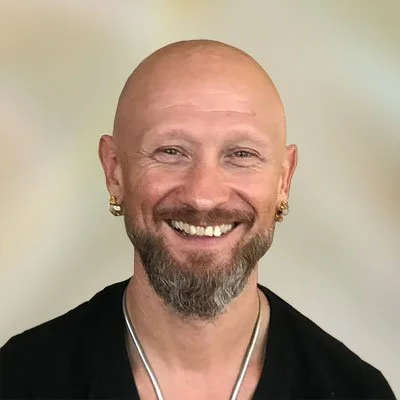Giten Tonkov
Founder of BioDynamic Breathwork & Trauma Release Institute
Giten is a Licensed Massage Therapist since 1994 (Swedish Institute of Massage Therapy, New York), and certified Breath & Body Oriented Therapist since 2001 (Diamond Breath School, Miasto Meditation Institute, Italy), as well as a former Osho Multiversity Therapist (OSHO Meditation Resort, Pune, India). He was born in Ukraine and lived in New York for 24 years, before finding his current home in the Santa Cruz Mountains, California.
Developer of the BioDynamic Breath & Trauma Release System®, Giten shares a mastery of body-oriented therapies that has evolved from over 20 years of learning, exploration and work with countless clients and groups around the world. His passion for life, humility and love for people has inspired his own personal journey and the creation of his “6-Element” approach to healing.
BioDynamic Breathwork & Trauma Release System’s® 6-Element approach empowers your body’s natural process for healing, restructuring your systems on a cellular level. Experiencing BBTRS® will leave you with ability to intimately connect with yourself and others, feel the “juice” of a vibrant life, and celebrate life to the fullest.
The 6-Element Approach
Breath: BBTRS® uses deep, connected breathing to “charge” the nervous system and provide access to the physical aspects of the trauma-release process. The full series of sessions allows tension to dissipate through movement, thus rebalancing your mind and body from head to toe.
Movement BBTRS® stimulates the natural expression of the body to release held energy through movement. The movement is invited through somatic (body-based) and creative/dance exercises. From playful warm-ups, to organic, whole-body tremors, to undulating spinal waves, movement is key to what makes BBTRS® truly transformative.
Sound: Trauma causes an orchestra of tiny cellular reactions to occur within contracted tissues. Fortunately, sound can help “loosen things up.” In BBTRS® sessions with people especially attuned to sound, vocalization, recorded music, and live instrumental sounds can provide interesting impacts, either in the entire body or in specific regions.
Touch: Conscious touch, bodywork, and soft-tissue manipulation allow a practitioner to assist a person in the physical aspects of trauma release. When we apply touch to contracted muscles in the body, we support a flow of energy to areas cut off from their own physical and energetic circulation. In BBTRS®, understanding how and when to use conscious touch is central to all trainings.
Emotions: Emotion is held along with body tension, and both come to the surface during somatic work. However, BBTRS® is structured to avoid reactivating people, and therefore steers away from overstimulation. Our balanced approach honors what is coming out emotionally, and then connects that experience to the body—allowing people to release and integrate trauma, rather than simply relive it or become overwhelmed.
Meditation: Meditation allows us to develop our inner witness—and it is where BBTRS® begins and ends. It is the most effective path to sense and integrate what is happening as a session unfolds. Different meditations are used within our training, from physical movement to sitting silently.


